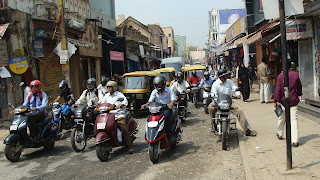VARAMAHALAKSHMI POOJA
Decorated Kalasam
Pooja being performed

Another view of Goddess
In my younger days, I remember that this festival was observed only by a certain community, mostly by gold smiths. These days everyone is celebrating. In a way it is good , as it brings all the hindus together.
I our family my mother never observed this festival. But in my wife's family, it is a very important festival. We used to visit my in-laws place along with our children. i do not remember the exact period, my wife introduced the festival in our family. It is a very nice and colorful festival festival. I think it is the only festival, wherein only ladies do all the arrangements on the day of the festival. Being the male member of the family I will hav e to man the kitchen and prepare the food for others.
Actually the preparation starts at least a fortnight in advance. The preparation starts with cleaning of the house and in most of the cases repainting of the house. Purchase of sarees for the Goddess. Earlier people used to purchase gold ornaments. Now the gold price is sky rocketing, people go for silk sarees.This was the case in our house as well. Then comes washing of curtains and sofa covers. Finally it is drawing of rangoolis with color paints.
On the day of the festival starts the purchase of all kinds of pooja articles, right from banana plants to color threads. Then the purchase of fruits. Finally, comes the purchase of flowers. This year I could access the flowers were the costliest items. The rates varied from Rs 30 to 60. The vendors were dictating terms. No bargains!
Then starts the work of decorating the Goddess A table is used as a pedestal, a new table cloth spread on it neatly. A kalasam is prepared. KALASAM - water is filled in a medium sized vessel with round bottom (Sombu). The vessel may a copper,bronze or silver metal. A small piece of camphor, some elachi, some tulasi and vilva leaves, little rose water and a gold ornament like ring or chain put into the vessel. One end of some seven good mango leaves placed in the vessel in such a way that the sharp end of the mango leaves visible out side. A good shaped coconut smeared with termaric powder and vermilion placed at the mouth of the vessel in such a way that the eye portion with the fibre of the coconut visible on top. a face of Goddess Lakshmi is fixed to the fibre of the coconut. The face of Goddess Lakshmi is available in all jewellery shops. Again the Goddess is decorated with jewels and plenty of flowers.Finally two small banana plants are placed on either side of the Kalasam. Whole pedestal is decorated with serial lights. Sweets and different verities of fruits are placed before the Goddess in trays. With this decorating of Goddess Mahalakshmi ends.
At an auspicious time Pooja is performed with a song "Bagyadha Lakshmi baramma .. .. .." All the married
ladies in the neighborhood are invited and given Thambulam with blouse piece and one rupee coin. Goddess remains in the house for three days and dismantled at the end of the third day.
Indeed it is a colorful festival. Everyone in the family enjoyed the occasion. I also throughly enjoyed it.















